Writer – Marshall Cavendish
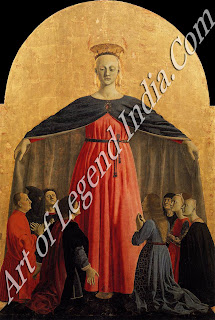 This is the central panel of Piero's earliest known work, an altarpiece commissioned by the Compagnia Della Misericordia Borgo sun Sepolcro. The Misericordia still exists and is an organization of laymen dedicated to performing works of mercy, particularly those involving the care of the sick and burial of the dead. The Virgin is shown as the Madonna of Mercy, patroness of the Misericordia, vast in scale and symbolizing the protection of the heavens. One of the kneeling figures has a black hood over his head part of the habit of the Misericordia that is still worn when the members carry the dead.
This is the central panel of Piero's earliest known work, an altarpiece commissioned by the Compagnia Della Misericordia Borgo sun Sepolcro. The Misericordia still exists and is an organization of laymen dedicated to performing works of mercy, particularly those involving the care of the sick and burial of the dead. The Virgin is shown as the Madonna of Mercy, patroness of the Misericordia, vast in scale and symbolizing the protection of the heavens. One of the kneeling figures has a black hood over his head part of the habit of the Misericordia that is still worn when the members carry the dead.  Piero's Flagellation is one of the most enigmatic paintings in the history of art. Numerous theories have been put forward to explain the three mysterious figures in the foreground, but none has met with universal acceptance. There is agreement, however, that this radiant work is one of the most beautiful paintings of the Renaissance.
Piero's Flagellation is one of the most enigmatic paintings in the history of art. Numerous theories have been put forward to explain the three mysterious figures in the foreground, but none has met with universal acceptance. There is agreement, however, that this radiant work is one of the most beautiful paintings of the Renaissance. 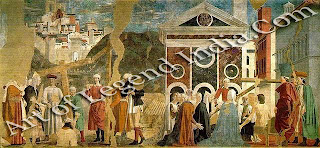 The 'Invention' is the name given to the discovery of the True Cross by the Empress Helena. Christ's cross cannot be distinguished from those of the two thieves until a funeral procession passes by and the corpse is resuscitated when the True Cross is passed over him.
The 'Invention' is the name given to the discovery of the True Cross by the Empress Helena. Christ's cross cannot be distinguished from those of the two thieves until a funeral procession passes by and the corpse is resuscitated when the True Cross is passed over him. Piero's pair of paintings of the ruler of Urbino and his wife are among the most distinctive portraits of the Renaissance. Portrayal in pure profile was common in Italy at this time, but the expansive landscape behind the sitters was unprecedented. The town visible behind Battista is Borgo san Sepolcro, acting as a kind of signature for Piero.
Piero's pair of paintings of the ruler of Urbino and his wife are among the most distinctive portraits of the Renaissance. Portrayal in pure profile was common in Italy at this time, but the expansive landscape behind the sitters was unprecedented. The town visible behind Battista is Borgo san Sepolcro, acting as a kind of signature for Piero. Piero painted this fresco for the town hall of Borgo Sepolcro the name means 'Borough of the Holy Sepulcher' and Christ`s featured on its coat of arms, Vasari, who said that this awesome painting was considered Piero's finest work, described the second front the left as a self-portrait of the artist.
Piero painted this fresco for the town hall of Borgo Sepolcro the name means 'Borough of the Holy Sepulcher' and Christ`s featured on its coat of arms, Vasari, who said that this awesome painting was considered Piero's finest work, described the second front the left as a self-portrait of the artist.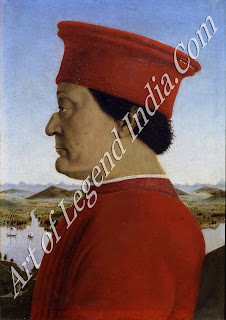 Federigo, the Count (later Duke) of Urbino, was one of the most distinguished men of his time as much a scholar as a soldier. The choice of a profile view for his portrait was dictated by the horrible injury he sustained in a tournament, when he lost his right eye; his disfigured nose was a result of the same accident.
Federigo, the Count (later Duke) of Urbino, was one of the most distinguished men of his time as much a scholar as a soldier. The choice of a profile view for his portrait was dictated by the horrible injury he sustained in a tournament, when he lost his right eye; his disfigured nose was a result of the same accident.
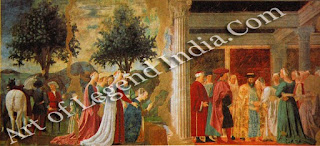

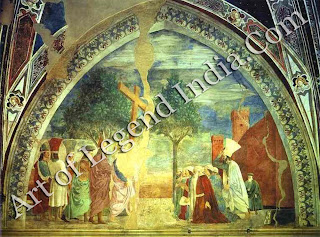










0 Response to "Painting Gallery of Piero della Francescasca"
Post a Comment